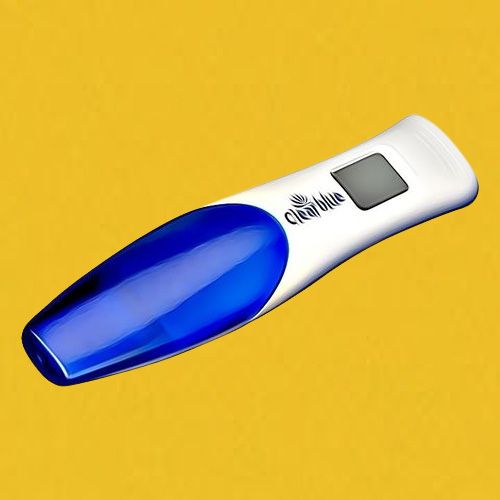The History Behind Clearblue
Clearblue pregnancy tests have been around since the late 1980s. Many people believe the brand is American but it was actually a UK firm called Unipath that first launched the Clearblue brand in 1987. At the time, home pregnancy testing was not at easy as it is now. To check for the presence of the pregnancy hormone, human chorionic gonadotropin (hCG), women would normally collect a urine sample and dip a test strip into it.
With the release of the Clearblue Easy pregnancy test in 1989, Clearblue turned the pregnancy testing industry on its head. With a plastic stick with an absorbent tip and a window to show the results, this innovative test used an easy-to-use design. Additionally, it boasted the ground-breaking “no mess” technology, which freed women from the necessity to collect pee in a cup.
Clearblue has continued to introduce revolutionary features to its pregnancy tests during years. Clearblue introduced the Digital Pregnancy Test in 1997, replacing the conventional line-based results with an easy-to-read digital display of “Pregnant” or “Not Pregnant.” With this invention, Clearblue to resolve the difficulty in understanding fine lines on a normal pregnancy test device. The digital test they introduced was a major milestone in the history of the pregnancy test.
Accuracy of Clearblue Pregnancy Tests
Clearblue pregnancy tests are highly accurate. In fact, when used according to the instructions, Clearblue pregnancy tests are 99% accurate in detecting the presence of the pregnancy hormone, hCG, in a woman’s urine.
Clearblue pregnancy tests detect hCG in urine, which is produced by the placenta shortly after a fertilised egg attaches itself to the uterine wall. This happens approximately six days after conception, and the hCG hormone rapidly increases in the mother’s blood and urine. Clearblue can detect hCG levels as low as 25 mIU/ml, so it is able to detect the presence of pregnancy at an earlier stage than most other tests.
The accuracy of a Clearblue pregnancy test is enhanced further by the convenient digital display. Rather than trying to interpret unclear lines on a traditional test, a Clearblue test will give you a clear ‘Pregnant’ or ‘Not Pregnant’ result. This feature is one reason why many couples like using the Clearblue Digital Early Detection Pregnancy Test. The Clearblue Digital Pregnancy Test with Weeks Indicator takes this process a step further. Not only does it tell you if you are ‘Pregnant’ or ‘Not Pregnant’, it also tells you how many weeks gone you are.
How to Use Clearblue Tests
The Clearblue tests are very accurate, but proper usage can be the difference between receiving accurate readings and not. Here are some tips on using them:
- Read the instructions carefully before you start.
- Use first morning urine for the most accurate results since it is more concentrated.
- Place the absorbent tip in your urine stream for 5 seconds or dip in a collected sample for 20 seconds.
- Lay the test flat while waiting for results.
- Check results within the timeframe described in the instructions.
- Avoid repeating tests or reading results after the maximum storage time is exceeded.
Note: Some factors that may influence your results include various medications, certain medical conditions, and testing extremely early. If you are ever doubtful or have unexpected results, then wait a few days and test again. If the problem persists, then you can chat with your doctor.
The guidelines should be followed to get the most accurate results of your Clearblue Pregnancy Test. Remember, as good a measure as these at-home tests are, they aren’t perfect. A visit to the doctor is always the best way to confirm pregnancy.
Other Clearblue Pregnancy Test Options
If this all sounds a bit too techy, you might want to try the Clearblue Rapid Detection Pregnancy Test instead. Created to be the simplest home pregnancy test to use, this test will show a cross mark in the test window if you are pregnant. Similarly simple and easy to use is the Clearblue Early Detection Pregnancy Test which can be used up to 6 days before your missed period.
It is worth bearing in mind that undesired results can occasionally occur with Clearblue pregnancy tests. False positives (when the result is ‘Pregnant’ when the woman is not in fact pregnant) are extremely rare, but false negatives (when the result is ‘Not Pregnant’ when the woman is in fact pregnant) can occur if the test is taken too early or if instructions are not followed correctly.
In conclusion, when used correctly, Clearblue pregnancy tests provide accurate and reliable results and are 99% accurate in detecting the presence of the pregnancy hormone, hCG. Clearblue pregnancy tests are a convenient, user-friendly way to determine whether or not you are pregnant.
Photo by Zoom Baby
This post was written in June 2022. It was last updated in July 2024.
Zoom Baby is a leading supplier of Pregnancy Tests and Ovulation Test Kits





